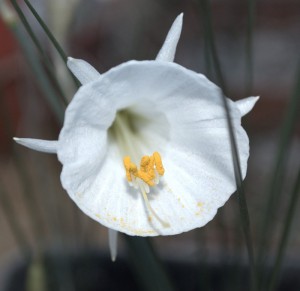On hoop-petticoats…
My PhD project, focusing on the taxonomy of hoop-petticoat daffodils, is examining techniques that can successfully be used for cultivar identification of this complex group.
With more that 30,000 recorded cultivar names for the genus Narcissus the issue of accurately underpinning identification on cultivar level is both challenging and complex. My present research is primarily focused on testing microsatellites in order to establish whether they can be a useful tool in distinguishing cultivars. Although I am focused on a relatively small section of the genus, the hoop-petticoat daffodils, I believe that if the technique is demonstrated to successfully and reliably work within this grouping then extensions for the genus are a true and exciting possibility.
I have also had the great opportunity to collect populations from the wild both in Spain and in Morocco. From the preliminary analysis of the collected data some very interesting patterns on the distributions of chloroplast DNA haplotypes have started emerging, an area that I would be very keen to examine and analyse further by including environmental factors such as climatic and geological data.
I am currently at the stage of my PhD where I am finishing my data collection and I am looking forward to the analysis and, more importantly, the interpretation of my results, aiming to complete within the next year. I am also involved in demonstrating and assisting the teaching of some biology undergraduate courses and some more specialised modules for the Masters students of the School of Biological Sciences.
In addition to my time at Reading, I had also had the opportunity to liaise with many experts in the field through my sponsor, the Royal Horticultural Society. Through a large variety of meetings, symposia and conferences I had the chance to discuss research issues and exchange ideas with a great number of scientific and horticultural experts,something that I have found invaluable in the course of my research.
As a trained taxonomist, my primary interests are in molecular techniques and their applications to solve taxonomical problems both in horticulture and general botany.
Publications from PhD research:
David, J., Könyves, K. (2013) The earliest published report of Narcissus bulbocodium in cultivation. In: Bradbury, M. S., Akers, W. M., Akers, J. L., Blanchard, J. W., Brickell, C. D., Davis, G., Duncan, B. S., Gibson, J., Hanks, G., Kington, S., Page, J. and Lady Skelmersdale, (eds.) Daffodil, Snowdrop and Tulip Yearbook. The Royal Horticultural Society, London, pp. 36-38. ISBN 9781907057410
Könyves, K., David, J. and Culham, A. (2011) Towards a reproducible system of identification for daffodil cultivars. In: Bradbury, M. S., Akers, W. M., Akers, J. L., Blanchard, J. W., Brickell, C. D., Duncan, B. S., Gibson, J., Hanks, G., Kington, S. and Lady Skelmersdale, (eds.) Daffodil, Snowdrop and Tulip Yearbook. The Royal Horticultural Society, London, pp. 26-29. ISBN 9781907057229
Könyves, K; David, J. & Culham, A (2016) Microsatellite Markers for Hoop-Petticoat Daffodils (Narcissus sect. Bulbocodii; Amaryllidaceae). Applications in Plant Sciences, 4(4) – DOI: http://dx.doi.org/10.3732/apps.1500127
Publications from other work:
Könyves, K; Culham, A (2014) C. colchicum – variation measured by DNA sequence. Cyclamen 38 (1): 18-21.
Armitage, JD; Könyves, K; Bailey, JP; David, JC & Culham, A (2013) A molecular, morphological and cytological investigation of the identity of non-native Ludwigia populations in Britain. New Journal of Botany 3 (2): 88-95.



Pingback: RHS KTP – practising and demonstrating excellence in horticultural science | Culham Research Group
Is managing a Herberium apart of your Phd training?
Pingback: A Multidimensional Greek Wedding | Tropical Biodiversity
Pingback: Advent Botany 2016 – Day 10: Hoop-petticoat daffodils | Culham Research Group
Pingback: Daughter of #adventbotany 2016 | Dr M Goes Wild